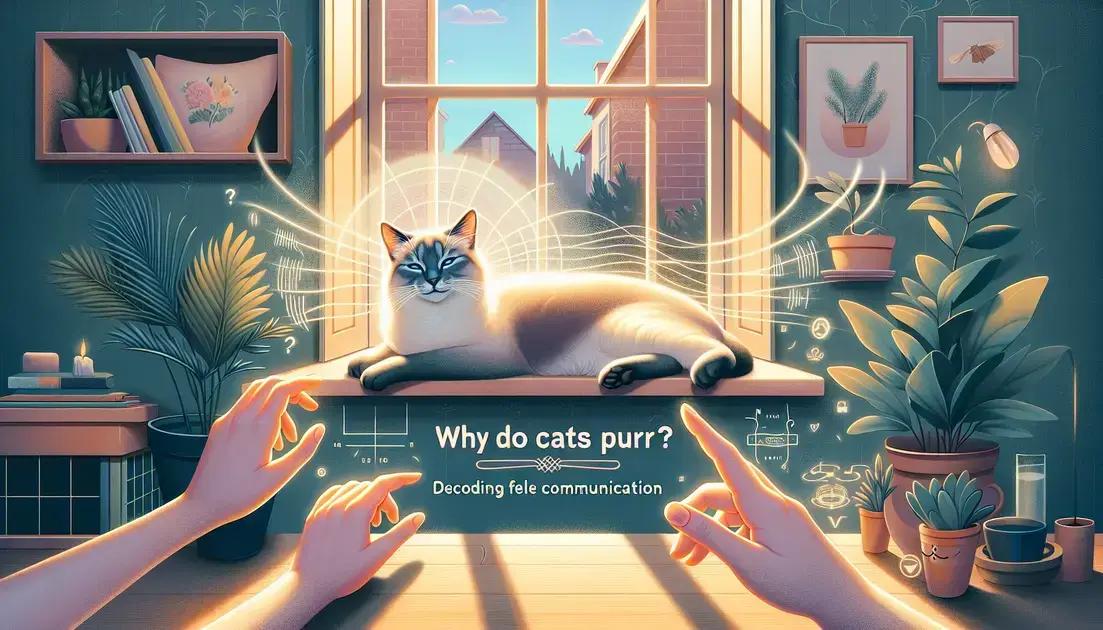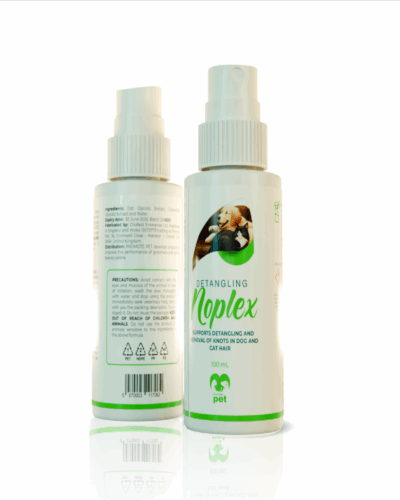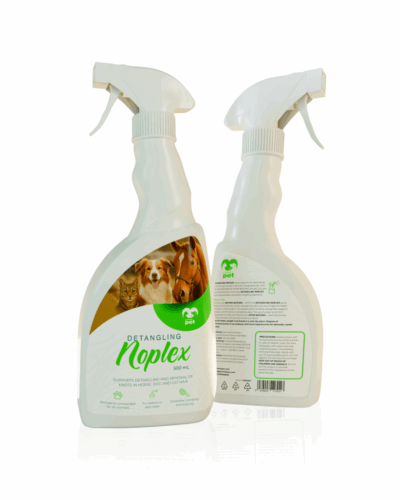Free delivery for orders over £45

Why Do Cats Purr? Decoding Feline Communication
Table of Contents
Have you ever wondered why cats purr? This fascinating behaviour is a core part of cat communication and feline behaviour. By understanding the reasons and methods behind a cat’s purr, we can better grasp their emotional and physical state. Delve into feline body language and nurture a deeper bond with your furry friend by exploring how purring enhances the human-cat relationship. Let’s unravel the secrets behind those soothing sounds.
The Science Behind the Purr
The feline purr is a complex form of communication generated by the laryngeal muscles of a cat. These muscles rapidly move, creating vibrations as air passes through the feline vocal cords. This mechanism cleverly operates under neural oscillator control within the brain, which sends repetitive signals to the laryngeal muscles, causing them to twitch in a rhythmic pattern.
Unlike human vocalisations, a cat doesn’t need to actively control their breathing to maintain the purring sound. Cats can purr while inhaling and exhaling, creating a continuous and soothing sound.
The frequency range of a cat’s purr, typically between 25 and 150 Hertz, aligns with frequencies shown to stimulate tissue regeneration. Some researchers suggest this frequency could be why cats tend to recover from ailments more rapidly than other animals.
These unique physiological processes within cats point to their purring as more than just a simple expression of content: it hints at deeper, evolutionary benefits possibly linked to self-healing and comforting communication cues within their species.
Different Types of Purring
When you hear a cat purring, it’s not just a one-size-fits-all affair. There are various types of purring, each serving a different purpose. Typically, we associate purring with a cat that’s content and relaxed. This is often the case, especially when they curl up on your lap or bask in the sun.
However, purring can also be a sign of discomfort or stress. Some cats purr when they are in pain, as the vibration may help them self-soothe or even promote healing. Research supports that these vibrations have therapeutic properties.
Besides expressing comfort or pain, cats sometimes purr to communicate with their kittens or human companions. A mother cat may purr to guide her blind and deaf kittens shortly after birth, creating a familial bond.
Furthermore, some cats use a specific type of purr to indicate a desire for food or attention. This particular purr tends to have a higher pitch or frequency, often combined with other vocalisations as they interact with humans.
Each cat may have its unique purring pattern, so it’s beneficial to understand their context and frequency. Paying attention to these different purrs offers valuable insights into a cat’s emotions and needs, enhancing the bond between you and your feline friend.
Purring as a Means of Communication
Cats have long been subjects of fascination and mystery, particularly in how they communicate through various vocalisations and behaviours. Among these, purring stands out as a key form of communication. It is more than merely a noise of contentment; it holds deeper meanings and serves distinct purposes in the feline world.
Firstly, purring can signify a means of communication between a mother cat and her kittens. From birth, kittens are blind and deaf, but they can feel the vibrations of their mother’s purrs, which guide them and provide a sense of safety. This form of communication strengthens their bond and reassures the young kittens as they navigate their new environment.
In interactions with humans, cats use purring to express a myriad of emotions and needs. A cat might purr loudly to indicate its happiness or to seek attention and care. This gentle vocalisation can be a subtle way to remind humans of its presence or prompt them to engage in activities such as petting or feeding.
Moreover, purring can have a soothing effect, not only for the cat itself but also for human companions. It is suggested that the frequency of a cat’s purr has therapeutic properties, capable of calming anxiety and stress in both parties involved. As a self-soothing mechanism, cats may also purr when they are sick or injured, indicating that their purring serves a self-healing purpose.
While the underlying mechanisms of purring are rooted in physical biology, its implications extend into the realm of social interaction, making it a vital component of how cats communicate their intentions, feelings, and needs with others.
Purring and Human-Cat Relationship
The relationship between humans and cats is enriched through purring, a unique form of feline communication. When cats purr around humans, it often signifies a connection that goes beyond simple companionship. This gentle vibrational sound is a reflection of comfort, affection and sometimes, a solicitous behaviour from the felis catus.
During moments of closeness, such as when a cat curls up on a lap or shares a quiet space, purring serves as a bridge between the feline and human worlds. Cats often purr when they feel at ease, contributing positively to a person’s sense of well-being and reducing stress.
Additionally, the purring sound may cater to a human’s need for emotional support, acting as a soothing presence during difficult times. From a psychological perspective, this mutually beneficial interaction fosters a sense of security and companionship, which is integral in nurturing the bond.
Every purring experience is unique, resonating with individuals in diverse ways depending on personal interactions and the particular dynamics of the human-cat relationship. Understanding these nuances further enhances the appreciation of why cats purr, allowing the relationship to flourish naturally.
Feline Body Language Decoded
When trying to understand feline body language, it is important to look for subtle cues that indicate a cat’s feelings, emotions, and intentions. Cats have a range of body signals that can help us interpret what they are attempting to communicate. Observing their tail movements can reveal a lot about their mood. A tail held high often indicates confidence and happiness, while a low tail may suggest fear or submission.
Moreover, pay attention to their ears and whiskers. Ears that are forward usually mean curiosity or interest, whereas ears flattened back can signify annoyance or aggression. Similarly, whiskers that are standing out from the face might suggest curiosity, while whiskers pulled back indicate stress or anxiety.
The position and movement of their body, such as an arched back or exposed belly, also provide valuable insight into their state of mind. An arched back with fur standing up usually signals fright or aggression, while an exposed belly can either mean trust or a defensive posture, depending on the context.
Purring, often paired with specific body language, further decodes feline communication. For example, a cat that is kneading with its paws, half-closing its eyes while purring, is generally expressing contentment and relaxation. In contrast, a cat that purrs while maintaining a defensive body posture (like a tucked tail or flattened ears) might be using purring as a self-soothing mechanism during stress or discomfort.
Recognising these non-verbal cues can foster a better human-cat relationship. By understanding the intricacies of feline body language, owners are better equipped to meet their pets’ needs and respond appropriately, enhancing the bond between them.
Understanding Cat Anxiety through Purring
Cats express emotions and needs through various behaviours, and purring can be a significant indicator of anxiety. This isn’t mere guesswork; knowing how and why purring occurs in anxious situations helps cat owners to better cater to their pets’ emotional health. Although purring often represents contentment, variations exist in their purring patterns that can showcase stress or discomfort.
When a cat purrs due to anxiety, it’s generally accompanied by other subtle body language cues. A close observation of their ears and tail can provide deeper insights. Ears pinned back or a tail closely wrapped around their body could indicate an anxious state. During these moments, the frequency and pitch of a cat’s purr might differ from when they’re relaxed.
Recognising these nuanced behaviours aids in deciphering the message your feline friend is trying to convey. It’s not solely about the sound; rather, it’s the comprehensive interpretation of their communicative signals. Just as with human emotions, feline feelings are complex. Understanding these helps mitigate stress, providing a more harmonious environment for both cat and owner.
How to Encourage Purring in Cats
One of the most delightful sounds a cat can make is a purr. It represents happiness, and knowing how to encourage it can deepen the bond you share with your feline friend. Encouraging purring involves understanding your cat’s preferences and creating a conducive environment.
Cats often purr when they feel safe and relaxed. Providing a comfortable, peaceful environment is key. Ensure your cat has a calm space to retreat to when it seeks comfort. You can also try different types of bedding and blankets to find what your cat prefers.
Interaction is significant. Petting helps stimulate purring. Gently stroke your cat from head to tail, observing their reactions. Some cats like gentle butt scratches or chin rubs, while others enjoy a more rhythmic motion. Experiment to discover what makes your cat feel content.
Playtime is another opportunity to encourage positive behaviour. Engaging your cat with toys and games can incite happiness. After an active play session, many cats feel serene and begin to purr.
Communication is vital. Talk to your cat in a soft, soothing voice. Cats are sensitive to their human’s tone. The more relaxed they feel, the more likely they are to respond with a purr.
Reward purring by giving healthy treats. This positive reinforcement technique associates purring with good things, thereby promoting its frequency.
Patience and consistency are crucial. Every cat is unique. Observe what makes yours feel secure. Over time, a consistent routine will bolster their purr-filled moments.
Encouraging your cat to purr not only strengthens your bond but also enhances their overall well-being, offering both joy and companionship.
Contact Us
- +44 07391626201
- info@promotepet.com
- 16, Cromwell Close - Oxford - UK
COPYRIGHT © PROMOTE PET. ALL RIGHTS RESERVED. © 2024 Chofard Enterprise Ltd. Chofard Enterprise is a company registered in England and Wales with a company number 13073779 VAT number GB 370644889. 16, Cromwell Close, Oxford OX30RW, United Kingdom – trading as Promote Pet Online Shop.











